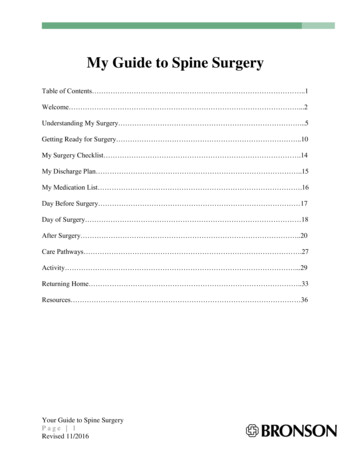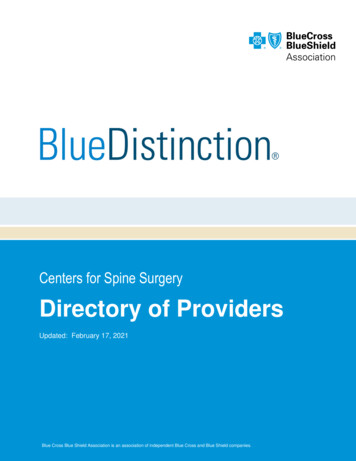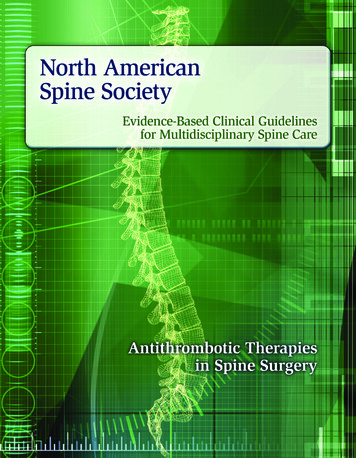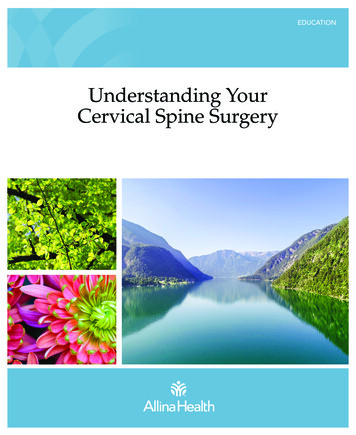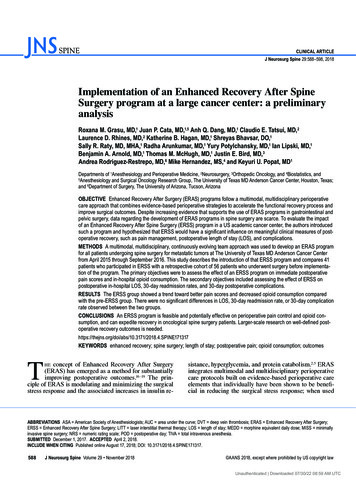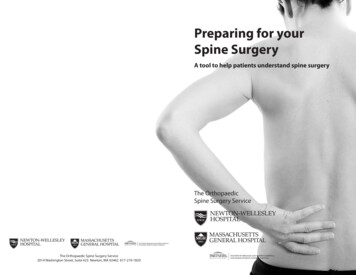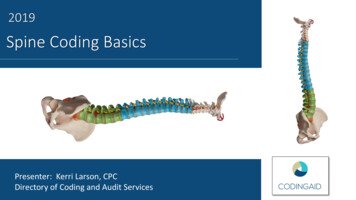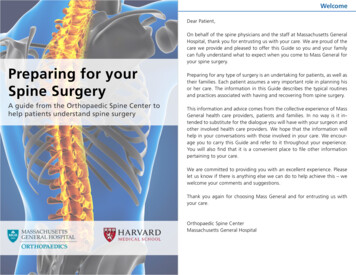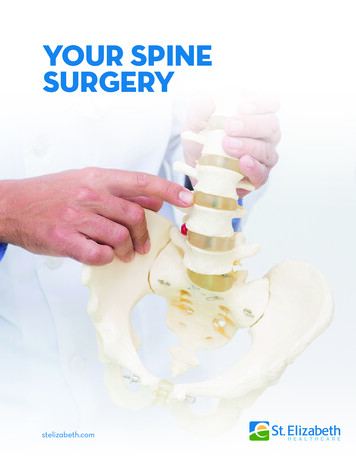
Transcription
Your SpineSurgerystelizabeth.com
CONTENTSWelcome to the St. Elizabeth Spine and Orthopaedic Center.3Preparing for Your Spine Surgery.3Get to Know Your Spine.4Regions of the Spine.5Spinal Curvature.5Types of Spine Surgeries.5What to Expect Throughout Your Hospital Stay.6The Day of Surgery. 7Helpful Hints for Your Hospital Stay.8Medication Side Effects.9Preparing Early for Your Hospital Discharge.9Orthopaedic Equipment Needs.10Possible Complications Associated with Spine Surgery.11Frequently Asked Questions Regarding Spine Surgery.12Restrictions.12Activity.12Precautions at Home. 14Follow-up Care.15Summary.15Important Phone Numbers.15
WELCOME TO THE ST. ELIZABETH SPINE ANDORTHOPAEDIC CENTEROn behalf of St. Elizabeth Healthcare, your orthopaedic surgeon and the entire spine care team, we would like tooffer you a warm welcome into our family.This booklet has been designed to assist you in gaining an understanding of the spine surgery process. With theassistance of the St. Elizabeth Spine Center, you will feel better prepared for your surgery, hospital stay, dischargeand post-discharge care. This booklet answers many questions about spine surgery and will help to ensure youunderstand the steps necessary to have a successful experience.The spine care team is dedicated to providing compassionate care and outstanding patient education material toguide you. The physicians, nurses, physical therapists, occupational therapists, care coordinator, nurse managers andmany others will be available to you should you need assistance in any way. There is also a list of important telephonenumbers located in the back of the booklet for quick reference.We hope that you find this booklet valuable while you prepare for your surgical experience. Spine surgery is expectedto provide significant relief of your pain and symptoms experienced prior to surgery. By following the advice of yoursurgeon, therapists, and other healthcare professionals, your spine surgery should put you back on the road to amore active lifestyle.- The St. Elizabeth Healthcare TeamPreparing for Your Spine SurgeryWith the help of your surgeon, you have decided to have spine surgery. It is important to realize that you will beresponsible for a major portion of your rehabilitation. Rest assured, there will be many healthcare professionalsto guide you step-by-step. If you follow the instructions of your doctors, therapists and nurses, and are an activeparticipant in your rehabilitation process, you will soon be on your way to a more active lifestyle.This booklet is designed to provide helpful information on what to expect with spine surgery. If you have anyquestions on subjects that are not covered, please ask your doctor or therapist for further information.This booklet will cover: Elements of the spine Regions of the spine What to expect throughout your hospital stay Possible complications Frequently asked questions Precautions at home Follow-up care Important phone numbersSt. Elizabeth Healthcare - Your Spine Surgery3
Get to Know Your SpineThe elements of the spine are designed to protect the spinal cord, support the body and facilitate movement.VertebraeThe vertebrae support the majority of the weightimposed on the spine. The body of each vertebra isattached to a bony ring consisting of several parts. Abony projection on either side of the vertebral bodycalled the pedicle supports the arch that protects thespinal canal. The laminae are the parts of the vertebraethat form the back of the bony arch that surrounds andcovers the spinal canal. There is a transverse processon either side of the arch where some of the muscles ofthe spinal column attach to the vertebrae. The spinousprocess is the bony portion of the vertebral body thatcan be felt as a series of bumps in the center of aperson’s neck and back.VERTEBRAEFACET JOINTINTERVERTEBRALDISCNEURAL FORAMENIntervertebral DiscBetween the spinal vertebrae are discs, which function as shock absorbers and joints. They are designed to absorbthe stresses carried by the spine while allowing the vertebral bodies to move with respect to each other. Each discconsists of a strong outer ring of fibers called the annulus fibrosis, and a soft center called the nucleus pulposus. Theouter layer (annulus) helps keep the disc’s inner core (nucleus) intact. The annulus is made up of very strong fibersthat connect each vertebra together. The nucleus of the disc has a very high water content, which helps maintain itsflexibility and shock-absorbing properties.Facet JointThe facet joints connect the bony arches of each of the vertebral bodies. There are two facet joints between eachpair of vertebrae, one on each side. Facet joints connect each vertebra with those directly above and below it, andare designed to allow the vertebral bodies to rotate with respect to each other.Neural ForamenThe neural foramen is the opening through which the nerve roots exit the spine and travel to the rest of the body.There are two neural foramen located between each pair of vertebrae, one on each side. The foramen creates aprotective passageway for the nerves that carry signals between the spinal cord and the rest of the body.Spinal Cord and NervesThe spinal cord extends from the base of the brain to the area between the bottom of the first lumbar vertebra andthe top of the second lumbar vertebra. The spinal cord ends by diverging into individual nerves that travel out to thelower body and the legs. Because of its appearance, this group of nerves is called the cauda equina - the Latin namefor “horse’s tail.” The nerve groups travel through the spinal canal for a short distance before they exit the neuralforamen.The spinal cord is covered by a protective membrane called the dura mater, which forms a watertight sac around thespinal cord and nerves. Inside this sac is spinal fluid, which surrounds the spinal cord.The nerves in each area of the spinal cord are connected to specific parts of the body. Those in the cervical spine,for example, extend to the upper chest and arms; those in the lumbar spine the hips, buttocks and legs. The nervesalso carry electrical signals back to the brain, creating sensations. Damage to the nerves, nerve roots or spinal cordmay result in symptoms such as pain, tingling, numbness and weakness, both in and around the damaged area andin the extremities.St. Elizabeth Healthcare - Your Spine Surgery4
Regions of the SpineHumans are born with 33 separate vertebrae.By adulthood, we typically have 24 due to thefusion of the vertebrae in the sacrum.Cervical Vertibrae(Lordosis) C - CThe top seven vertebrae that form the neckare called the cervical spine and are labeledC1-C7. These vertebrae are responsible forthe normal function and mobility of the neck.They also protect the spinal cord, nerves andarteries that extend from the brain to the restof the body. CCCC C C C TTTT T T T T T Thoracic Vertibrae(Kyphosis) T - T T TTThe upper back, or thoracic spine, has 12vertebrae, labeled T1-T12.LLThe lower back, or lumbar spine, has fivevertebrae, labeled L1-L5. The lumbar spinebears the most weight relative to otherregions of the spine, which makes it acommon source of back pain.L L SacrumThe sacrum (S1) and coccyx (tailbone) aremade up of nine vertebrae that are fusedtogether to form a solid, bony unit.Spinal CurvatureLLumbar Vertibrae(Lordosis) L - L CoccyxFRONTSIDEBACKThe Spinal ColumnWhen viewed from the front or back, the normal spine is in a straight line, with each vertebra sitting directly on top ofthe other. Curvature to one side or the other indicates a condition called scoliosis.When viewed from the side, the normal spine has three gradual curves: The neck has a lordotic curve, meaning that it curves inward. The thoracic spine has a kyphotic curve, meaning it curves outward. The lumbar spine also has a lordotic curve.These curves help the spine to support the load of the head and upper body, and maintain balance in the uprightposition. Excessive curvature, however, may result in spinal imbalance.Types of Spine Surgeries Minimally Invasive Lumbar Discectomy Anterior Cervical Discectomy with Fusion (ACDF) Lumbar Laminectomy Anterior Lumbar Interbody Fusion (ALIF) Posterior Lumbar Interbody Fusion (PLIF) Transforaminal Lumbar Interbody Fusion (TLIF) Cervical Disc Replacement Cervical CorpectomySt. Elizabeth Healthcare - Your Spine Surgery5
You are the only one who can decide to have spinal surgery. It is important that you take ownership of this decision,recognizing the limitations your particular physical condition places on the potential success of each of the treatmentoptions. If you choose to have spine surgery, your physical condition and your mental attitude will play a roleyour body’s ability to heal. You must approach your surgery with confidence, a positive attitude, and a thoroughunderstanding of the anticipated outcome. You should have realistic goals and work steadily to achieve those goals.The decision to have or not to have spinal surgery includes weighing the risks and benefits involved. You will makethe final decision; so ask your spine surgeon questions about anything you do not understand. Since medical care istailored to each person’s needs and differences, not all information presented here will apply to your treatment or itsoutcome. Seek the advice of your physician and other members of the healthcare team for specific information aboutyour medical condition.What to Expect Throughout Your Hospital StayFor the well being of all staff and patrons, St. Elizabeth Healthcare is a smoke-free campus.Weeks Leading up to SurgeryYour well being is our primary concern at St. Elizabeth Healthcare. We want your spine surgery experience to be thebest it can be. Following these instructions will help ensure a safe and smooth transition to a more active lifestyle.Below is a list of important instructions to follow in the weeks prior to your surgery: Stop any medications as instructed by your physician at the appropriate time. You must bring a list of your home medications with you on the day of surgery that must include the name of themedication, dosage and how often you take it. If you have a Living Will or Durable Power of Attorney, please make a copy and bring it with you on your dayof surgery. Bring a pair of good walking shoes, pajama pants, shorts or sweatpants, and a robe with you. Report any of the following to your physician should they arise: Fever Breathing problems Open cuts/abrasions/rashes Changes in your medications Tooth pain or infection Bug bites Urinary infections Any change in your current health status Please inform your physician if you have been taking any antibiotics prior to surgery. You will need to have afollow-up visit with your prescribing physician.St. Elizabeth Healthcare - Your Spine Surgery6
Day of SurgeryThe day you have been waiting for has finally arrived. It is important to understand what will occur from the time ofarrival at the hospital until you are discharged. Being knowledgeable and prepared for your spine surgery experiencewill help to alleviate your fears and anxiety. Be assured that we are dedicated to assisting you every step of the way.Below is a list of things to expect on the day of your surgery: You must NOT eat or drink anything after midnight on the night before your surgery unless directed otherwise. Take the medications you were instructed to take by the nurse practitioner or physician in Pre-Admission Testing.You may take your medications with a sip of water. You may brush your teeth on the morning of surgery but DO NOT SWALLOW WATER. Do not chew gum or tobacco on the day of surgery. Avoid all alcoholic beverages, and stop or reduce smoking for 24 hours prior to surgery. Do not wear jewelry, artificial nails, nail polish or makeup on the day of surgery. Dentures can be removed before going to surgery. A container will be provided. Do not remove hearing aids; you will need to wear them to surgery. Please note that there are occasions when the time of your surgery may change. We ask that you be availabletwo hours before and after your scheduled surgery time to accommodate these changes should they occur. You will be asked to arrive two hours prior to your scheduled surgery time. This is to allow our personnel time toadequately prepare you for surgery. Your partner in care is asked to remain in the waiting area at all times during your surgery. Please bring any brace(s) your physician may have given you.When you arrive at the hospital, please report to Same Day Surgery unit where the following will occur: Your partner in care may be with you in this area. The nurse will collect any paperwork you were asked to bring to the hospital. The nurse will obtain the cell phone number of your partner in care. You will change into hospital attire. You will have an intravenous catheter placed for administration of medications. You will speak to a physician regarding your past medical history. Your surgeon will mark the operative site. An anesthesiologist will review your medical information and answer any questions you have. He/she will discussthe anesthetic plan with you. Medication will be given to you to help you relax prior to being taken to the operating room. You will be given an opportunity to ask any questions that you may still have. Other friends/family members may join you prior to moving to the operating room. Our staff are available to ensure your comfort until your surgery.St. Elizabeth Healthcare - Your Spine Surgery7
During SurgeryDuring surgery, the surgical nurse will keep your partner in care updated on your progress.Immediately Following SurgeryImmediately following surgery, you will still be drowsy from the medications given to you. The surgeon will speak toyour partner in care regarding the details of your surgery and will update them on your condition.When surgery is complete, you will be transported to the Post Anesthesia Care Unit (PACU). While in PACU, you willbe closely monitored and will remain until you are recovered enough to go home or until your private hospital roomis available. Your partner in care will be contacted via cell phone for an update. Patients who are admitted followingspine surgery spend the majority of their stay on the spine unit, the designated orthopaedic unit within our facility.Most patients remain on this unit for an average of 2-3 days.On the Spine UnitWelcome to the Spine Center! This is where you will spend the remainder of your surgical experience atSt. Elizabeth Healthcare. The staff of the Spine Center is committed to providing outstanding patient care to ourfamily of spine patients.While on the unit, you will be cared for by our many highly trained healthcare professionals. These individuals includeour orthopaedic nurses, nursing assistants, the nurse manager, physical therapists, occupational therapists, carecoordination, and many more. Please let us know if you have any concerns. Our goal is to make your stay atSt. Elizabeth Healthcare the best it can be.The Spine Center has private patient suites. Each room features a flat-screen television, accommodations for a familymember, and wireless internet access.Helpful Hints for Your Hospital StayActively participate in your recovery. No one can do this for you, but we will guide and assist you.Communicate your pain levels regularly so adequate medication can be used to help you.Set personal goals to maximize your potential and reduce recovery time.Follow doctors’ orders so that complication risks are lessened. Medications, blood clot prevention devices, bloodtests, physical therapy, etc. are prescribed to maximize the safety of your surgery and recovery.Clearly communicate concerns about any aspect of your care and recovery so that problems can be addressed.What you can do: Call for staff to assist you in getting out of bed. Call. Don’t fall! Do your breathing exercises, utilizing yourincentive spirometer Remember the spine precautions you were taught(e.g., “body mechanics, no BLT’s”). Have a list of any questions or concerns ready. Be as active as possible in your therapy. Bring up any concerns you have about going home. Move your ankles and feet often (ankle pumps) toincrease circulation. Tell the staff if you do not understand any instructionsfor your care at home. Ask questions about your progress. Understand that you may have some good days andsome bad days. Remember to ask for pain medicine before therapy. Keep a positive attitude. Notify your nurse if you experience a sore throat ornausea following surgerySt. Elizabeth Healthcare - Your Spine Surgery8
Medication Side EffectsBelow is a list of common medications you may receive during your hospital stay, and there possibleside effects. Antibiotics: Nausea, sore throat, sensitivity to sun, yeast infection, diarrhea, constipation, or dizziness. Anticoagulant (blood thinner): Unusual bruising or bleeding. Dizziness or muscle pain. Iron: Constipation, nausea, vomiting, abdominal pain, dark stool, or other GI complaints. Stool softener: Diarrhea, throat irritation, or stomach cramps. Pain medication: Constipation, dry mouth, itching, nausea, vomiting, or upset stomach. Anti-nausea medication: Dry mouth, constipation, drowsiness, or dizziness.Preparing for Your Hospital DischargeIt is important to plan ahead for your discharge from the hospital. While our staff will support you every step ofthe way, we suggest you think ahead about your needs and support available from family and friends after yourhospital stay. We strongly encourage you to designate one person to act as your Partner in Care. This individualshould be able to accompany you through each step of the spine surgery process. One of the most importantresponsibilities of your partner in care is to be available to you following discharge for 5-7 days until you canfunction more independently. Expected length of stay will vary depending on your general health prior to surgery.A care coordinator will assist you in making home arrangements, or in ordering any equipment you may need. Thecare coordinator can also assist in making arrangements for transportation if necessary. In some instances, it maybe necessary for a healthcare professional to provide follow up care at your home. You may also need continuedphysical therapy on an outpatient basis. These options will be discussed with you when you are close tobeing discharged.Possible discharge options depending on your specific needs include:Return Home with Outpatient Therapy Provides 2-3 days per week of progressive exercise for improving range of motion and strength.Return Home with Home HealthCare Provides one hour, 2-3 times per week of therapy. Provides skilled nursing and home health aide services if medically appropriate. Private-duty nursing services may be available, which are not generally covered by insurance.Transfer to Acute Inpatient Rehabilitation Provides three hours of therapy 5-7 days per week. Average length of stay is 7-10 days. Individuals would require at least two of the three therapies to qualify for this service. Please note that there are strict Medical Necessity Guidelines in order to qualify for this level of care, such asmultiple medical issues and ability to participate in intensive therapy.Transfer to a Skilled Nursing Facility Provides 60-90 minutes of therapy 5-6 days per week. The average length of stay varies based on medical necessity guidelines.St. Elizabeth Healthcare - Your Spine Surgery9
Planning for Discharge TransportationDon’t forget to arrange a plan for transportation home from the hospital. Most patients can travel by car. If yourhealthcare team feels it is medically necessary to travel by ambulance or wheelchair van, they will assist you inmaking these arrangements. If you have concerns about transportation, please let the care coordinator know assoon as possible after surgery.Equipment NeedsCervical collar: Neck brace used to immobilize/stabilize your spineafter surgery.Thoracolumbosacral or “TLSO” brace: Brace applied to your trunk/abdominalarea to immobilize/stabilize your spine after surgery. If you are using a TLSO,please bring a separate t-shirt to wear.A-boots/SCD/Athrombic Pumps: A-boots are intermittent devices applied tolower legs to promote circulation and help prevent blood clotsafter surgery.TED hose: Stockings applied to promote circulation and help prevent bloodclots after surgery.Walker: Assistive walking device.Cervical CollarIncentive Spirometer: Medical device used to assist patients to improve the function of their lungs.Before your surgical procedure, you should speak with your physician about any medical devices you may requirethroughout your spine surgery process. The physician may inform you that you will need a cervical collar brace, athoracolumbosacral brace, or various types of other medical devices. It is imperative that you bring this equipmentwith you the day of your surgery if prescribed by your physician. This and other equipment will be utilized in the earlypost-operative period and throughout your transition home. You may also require durable medical equipment suchas a rolling walker, cane, or toilet seat riser/extension for use after your hospital stay. To help lower cost of medicalexpenses, we encourage you to take inventory of any equipment you or your family may have access to in theinstance you require its use after discharge. This will allow a smoother transition home and eliminate additional costsand time spent at discharge.Questions Concerning EquipmentIf I require a walker, how long will I need to use this device?This varies from individual to individual. Everyone has different healing times. You can expect to be getting up toa chair within eight hours of surgery and getting up and walking the day after surgery. Your physical therapist willwork with you until you are safe walking with a rolling walker or other assistive devices depending on the type ofspine surgery that you have. Eventually, you may not need to use an assistive device at all depending on your generalhealth prior to surgery.If I require a back or neck brace, how long will I need to use this device?Depending on the type of spinal surgery you have your doctor may prescribe a neck or back brace for you to wear.Your nurses and physical therapists will instruct you on how to properly apply and remove your brace. Your surgeonwill leave instructions on how often the brace must be worn.A brace does three important things: immobilizes your spine during healing, stabilizes injured areas, and controls painby restricting movement. If you were placed in a brace after surgery, you will need to wear it until your first clinic visit.St. Elizabeth Healthcare - Your Spine Surgery10
Possible Complications Associated with Spine SurgeryPneumonia can be a complication after surgery because of immobility and pain medication side effects. To reducethe risk of developing pneumonia during your recovery period, you should utilize the following: Cough and deep breathing exercises. Incentive spirometer (IS). Early mobility.Blood Clots (also known as DVTs) are another possible complication following spine surgery due to immobility. Toreduce the risk of developing a blood clot/DVT during your recovery period, you should utilize the following: Athrombic boots while you are lying in bed. TED hose. Frequent ankle pumps as described by your nurse/therapist. Early mobility.Infection is another possible complication following surgery. To reduce the risk of developing infection during yourrecovery period, you should utilize the following: Wash your hands before touching your dressing or incision. Do not apply lotions, creams, powders or medications to your incision until approved by your physician. Keep your incision clean and dry according to your physician’s instructions. Do not bathe or soak in a tub, lake, pool, or any body of water until approved by your physician.Skin breakdown is another possible complication following surgery due to immobility. To reduce the risk of developingskin breakdown during your recovery period, you should utilize the following: Keep your heels off the bed as instructed by your nurse. Inform your nurse if you are sitting or lying on wrinkled or wet/soiled bed linens. Healthcare providers will encourage you to turn you every two hours to relieve pressure points that lead toskin breakdown. Inspect your skin under the brace whenever possible.Please speak to your surgeon for a complete list of potential complications associated with your specificspine surgery.St. Elizabeth Healthcare - Your Spine Surgery11
Frequently Asked Questions Regarding Spine SurgeryWhen will my pain go away?Due to the surgery itself, you can expect some pain and soreness for several weeks. Everyone is different, so theamount of pain varies from patient to patient; however, the pain you experience will be different from the pain orsymptoms you may have experienced prior to surgery. Pain that you may experience post operatively includes:pain from your surgical site, sore throat, or pain related to your bodies position during surgery. Your surgery shouldeventually relieve the pain and other symptoms you had prior to surgery.Is there anything I can do that will damage my post-operative spine?Your post-operative spine will be very strong and secure after surgery; however, there are some precautions thatmust be followed to ensure that your spine stays in good condition. Your nurses and physical therapists will reviewthese with you. In general, quick sharp movements, falls, bending and twisting of the trunk/neck and pushing/pullingof the arms should be avoided. Your nurses and physical therapists will teach you proper body mechanics in order toprevent injury.Restrictions Do not smoke and avoid being around anyone who smokes. It is recommended that you avoid all nicotinecontaining products (e.g., gum, patches, and electronic cigarettes). Smoking delays healing by increasing the riskof complications (e.g., infection) and inhibits the bones’ ability to fuse. Do not drive for 2-4 weeks after surgery or until discussed with your surgeon. Avoid sitting for long periods of time. Avoid bending, lifting and twisting.ActivityPhysical therapy will be an important part of rehabilitation after your spinal surgery. You will begin therapy the dayafter surgery. It will be necessary for you to relearn many everyday movements after your surgery as well as properbody mechanics. The first week after surgery, you may be up and walking about the house. This is a time of healing, soremember not to overdo any activity. Your body needs adequate rest, so if you feel tired, lie down and rest. Activitiesaround the house, such as washing dishes, fixing light meals, and your own personal care a
Spine surgery is expected to provide significant relief of your pain and symptoms experienced prior to surgery. By following the advice of your surgeon, therapists, and other healthcare professionals, your spine surgery should put you back on the road to a more active lifestyle. - The St. Elizabeth Healthcare Team Preparing for Your Spine Surgery


